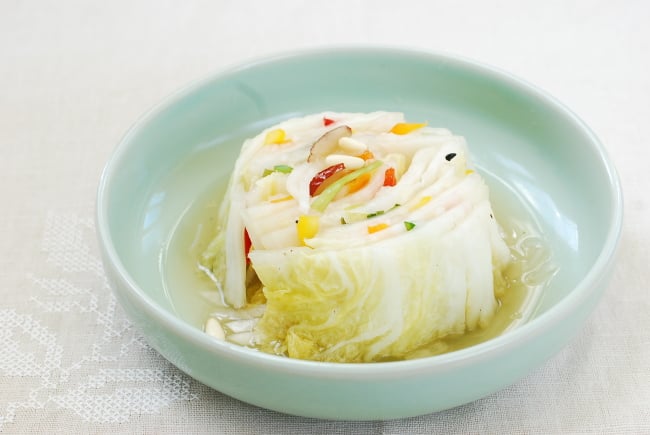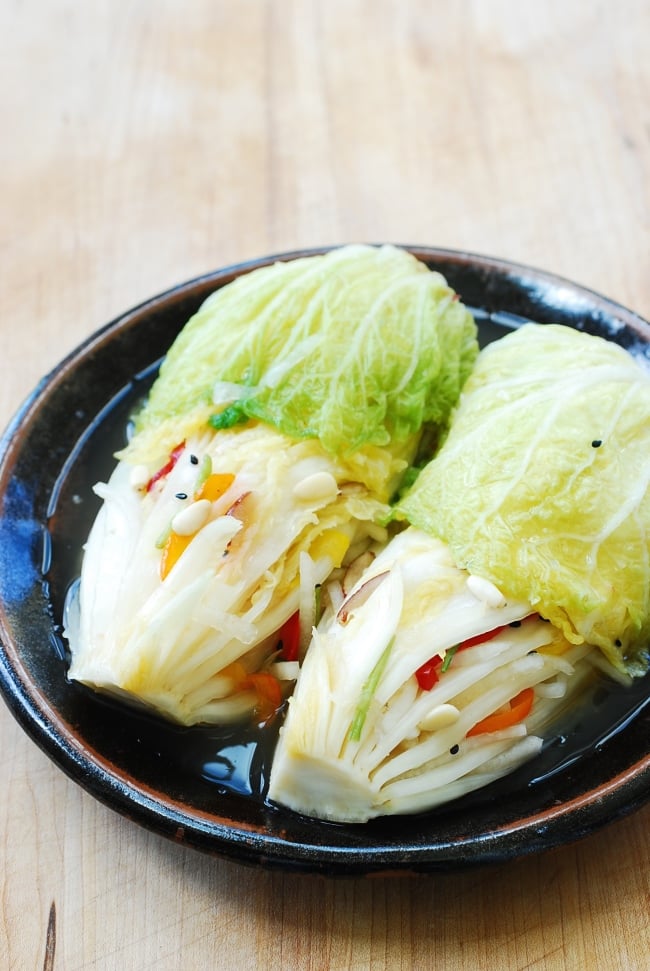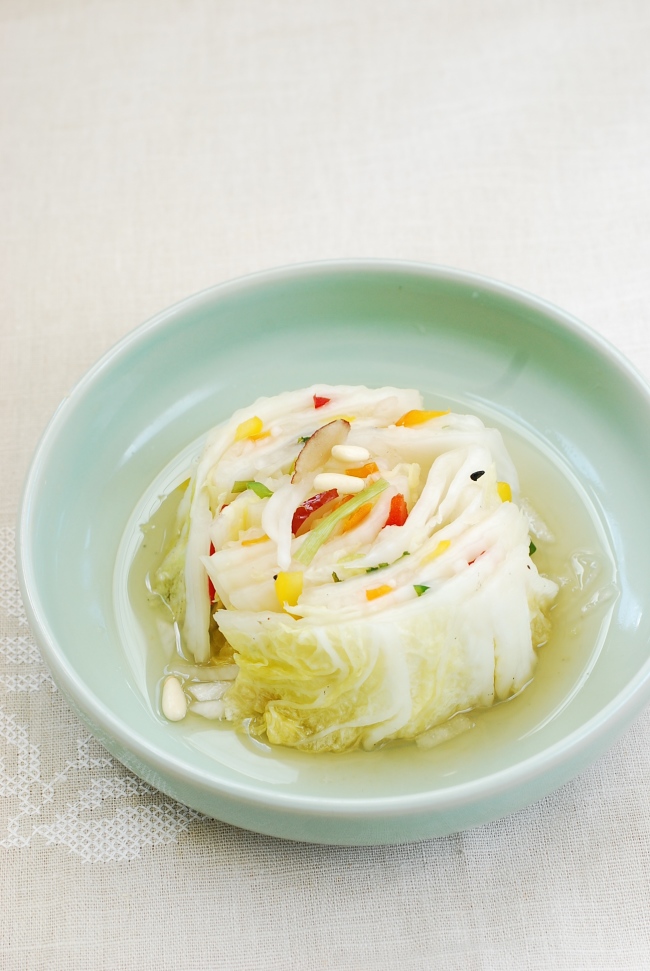It’s kimchi making season again! Last weekend, I bought a big box of napa cabbages and made two types of kimchi – pogi kimchi and this baek kimchi (white kimchi). Baek kimchi (백김치) is a variety of kimchi that’s made without red chili pepper flakes. Baek means white. Kimchi is obviously much more popular in its red spicy form, but white kimchi is enjoyed for its mild, refreshing taste. It’s child-friendly and great for people who have issues with spicy food!
Napa cabbages are in their prime these days, and they tend to be larger than the ones you find in the summer. Look for medium size cabbages (about 4 pounds) with deep green outer leaves and yellow inner leaves. Large ones tend to be soft and less sweet because of the high water content.
The best salt for salting the cabbages is Korean coarse sea salt, which are available at Korean markets. Korean sea salt is known for superior quality and high mineral content, which helps prevent the cabbages from softening quickly, while improving the taste of kimchi. It seems like kimchi recipes take so much salt, but a lot of it is washed off once the cabbages are properly salted.
The stuffing for white kimchi varies but usually includes typical kimchi ingredients such as radish, garlic, ginger, scallion, minari, pear, etc. I like to add colorful bell peppers, which are called paprika in Korea, for sweetness and additional colors. Traditionally, other ingredients such as pine nuts, jujubes, and chestnuts are also thrown into the baek kimchi stuffing. They are nice things to have, but not absolutely necessary.
Baek kimchi typically has a lot more water content than its red, spicy counterpart. The brine can be simply water and salt or flavored with other ingredients such as grated pear, garlic, ginger and salted shrimp. I usually add sweet rice (aka glutenous rice) powder paste. The rice paste is commonly used in kimchi. Among other reasons, the rice paste promotes fermentation by feeding healthy bacteria and helps develop the flavors of kimchi.
After a few days of fermentation, you will have mild kimchi that’s crunchy and full of subtle flavors with a bit of tang. The refreshing brine is great as a soup base for cold noodles.
(If this recipe is too much kimchi for you, you can easily half it.)
Ingredients:
2 medium napa cabbages (about 4 pounds each)
1-1/2 cups Korean coarse sea salt
7-1/2 cups water
Stuffing:
1 pound Korean radish (mu)
1/2 red bell pepper
1/2 orange or yellow bell pepper
1/2 large Korean pear
3 – 4 scallions
1 ounce minari, 미나리 – optional
1 tablespoon pine nuts – optional
4 to 5 chestnuts – optional
4 to 5 jujubes (daechu, 대추) – optional
1/4 cup salted shrimp (saeujeot, 새우젓), finely minced
1 tablespoon myulchiaekjeot (fish sauce)
2 tablespoons minced garlic
1 teaspoon grated ginger
1 teaspoon sesame seeds (optional)
Brine:
1 tablespoon glutinous rice powder*
(*Mix it with 1/2 cup water, simmer over low heat until it
thickens to a thin paste and cool. Yields about 3 – 4 tablespoons.)
4 cups water
salt to taste (start with 2 teaspoons)
 Cut the cabbage lengthwise into quarters by cutting the stem end in half (only about 4 inches in) and then slowly pulling apart to separate into two pieces by hand. Do the same for each half to make quarters. Running the knife through all the way would unnecessarily cut off the cabbage leaves.
Cut the cabbage lengthwise into quarters by cutting the stem end in half (only about 4 inches in) and then slowly pulling apart to separate into two pieces by hand. Do the same for each half to make quarters. Running the knife through all the way would unnecessarily cut off the cabbage leaves.
 In a large bowl, dissolve 3/4 cup of salt in 7.5 cups of water. Thoroughly bathe each cabbage quarter in the saltwater one at a time, shake off excess water back into the bowl, and then transfer to another bowl.
In a large bowl, dissolve 3/4 cup of salt in 7.5 cups of water. Thoroughly bathe each cabbage quarter in the saltwater one at a time, shake off excess water back into the bowl, and then transfer to another bowl.
 Using the remaining salt (3/4 cup) and starting from the outermost leaf, generously sprinkle salt over the thick white part of each leaf (similar to salting a piece of meat). You can use a little more if needed. Repeat with the rest of the cabbage quarters. Pour the remaining salt water from the first bowl over the cabbages. Set aside for about 6 – 8 hours, rotating the bottom ones to the top half way through.
Using the remaining salt (3/4 cup) and starting from the outermost leaf, generously sprinkle salt over the thick white part of each leaf (similar to salting a piece of meat). You can use a little more if needed. Repeat with the rest of the cabbage quarters. Pour the remaining salt water from the first bowl over the cabbages. Set aside for about 6 – 8 hours, rotating the bottom ones to the top half way through.
The cabbages for white kimchi should be ready to be washed when the white parts are soft and flexible, but not totally bendable. Rinse thoroughly 3 times, especially between the white parts of the leaves to wash off any lingering salt. Drain well, cut side down.
 Cut the vegetables and pear into match sticks (use a mandoline if available). Cut scallions and minari into 1-inch long pieces, collecting them in a bowl.
Cut the vegetables and pear into match sticks (use a mandoline if available). Cut scallions and minari into 1-inch long pieces, collecting them in a bowl.
 Combine the vegetables with the seasoning ingredients. Mix well by hand. Taste — It should be a bit too salty to eat as is. Add salt if necessary. Let it sit for 30 minutes to an hour.
Combine the vegetables with the seasoning ingredients. Mix well by hand. Taste — It should be a bit too salty to eat as is. Add salt if necessary. Let it sit for 30 minutes to an hour.
 Cut off the tough stem part from each cabbage quarter, leaving enough to hold the leaves together. Place one cabbage quarter in the bowl with the radish mix. Spread the radish mix over each leaf, one to two tablespoons for large leaves.
Cut off the tough stem part from each cabbage quarter, leaving enough to hold the leaves together. Place one cabbage quarter in the bowl with the radish mix. Spread the radish mix over each leaf, one to two tablespoons for large leaves.
Fold the leaf part of the cabbage over toward the stem and nicely wrap with the outermost leaf before placing it, cut side up, in a jar or airtight container. Repeat with the remaining cabbages.Once all the cabbages are in the jar or airtight container, firmly press down to remove air pockets.
 Make the glutinous rice paste and cool. Add 4 cup of water to the bowl that contained the radish mix. Stir in the rice paste and salt to taste (start with 2 teaspoons). Stir well. Pour over the kimchi.
Make the glutinous rice paste and cool. Add 4 cup of water to the bowl that contained the radish mix. Stir in the rice paste and salt to taste (start with 2 teaspoons). Stir well. Pour over the kimchi.
Leave it out at room temperature for a full day. Then, store in the fridge. Wait 5 to 7 days before eating. White kimchi doesn’t keep well as long as red spicy kimchi because it’s seasoned lightly and lacks chili peppers that help keep the kimchi from softening. Thus, it’s best eaten within a few weeks.
The post Baek Kimchi (White Kimchi) appeared first on Korean Bapsang.



